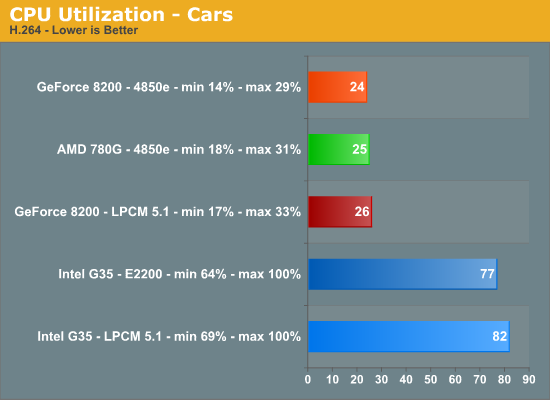AMD 780G: Preview of the Best Current IGP Solution
by Gary Key on March 10, 2008 12:00 PM EST- Posted in
- CPUs
H.264 Video Quality - Cars
One of our favorite movies last year was Cars from Disney / PIXAR. It may be a kid-oriented movie but who can resist fast cars and a love story to boot. This movie offers bitrate levels that average 14.1 Mb/s to 31.9 Mb/s. In our particular test scene, the Hudson Hornet is in the pit lanes acting as crew chief. This image provides an array of colors and contrast opportunities for dissection.
 780G – Click to Enlarge |
 G35 – Click to Enlarge |
 GeForce 8200 – Click to Enlarge |
The differences in the images are small but the GeForce 8200 appears to have slightly deeper colors along with a very slight edge in sharpness that we will discuss shortly. The reference image was in between the G35 and 780G, but even that decision was a tossup in our opinion. However, our test audience voted differently than the reference image with 4 votes in favor of the GeForce 8200, 3 for the G35, and 1 for the 780G.
This is one title that benefits from NVIDIA's new HD Dynamic Contrast and Color enhancements that will vary contrast ratios on the fly while enforcing a slightly stronger color palette across the image. We find this technology is well suited to animated titles but our opinions differ strongly when it comes to natural images. Almost all of us did not like the contrast enhancement technology but several thought the color enhancement feature offered a better overall picture in most cases.

Even though the G35 platform had an excellent image, there is no comparison in the CPU utilization rates during playback compared to the hardware accelerated decoding offered by NVIDIA and AMD. As expected, the 780G kills the G35 with average utilization rates at 25% compared to 77%. Of course, the G35 does not offer hardware acceleration for decoding H.264 (AVC) content and as such suffers from severe judder at times once the CPU utilizations rates go above 95.
In early Phenom testing with the 8.3 release drivers we noticed CPU utilization rates dropping several percent while image quality improved due to the post-processing capabilities on the HD 3200 when paired with an HT 3.0 capable CPU. We will have those results shortly.
VC1 Video Quality - Dave Matthews and Tim Reynolds
We are constantly playing our “Live at Radio City” Blu-ray disc featuring Dave Matthews and Time Reynolds from ATO/RCA/BMG record labels in the labs. It is one of our reference discs for audio quality and besides we just enjoy the music. This disc offers bitrate levels that averaged 13.06 Mb/s to 31.3 Mb/s. In our particular test scene, we see Dave and Tim performing from the right side of the stage. This image provides an array of colors, shadows, and various lighting angles for review.
 780G – Click to Enlarge |
 G35 – Click to Enlarge |
 GeForce 8200 – Click to Enlarge |
The differences in the images are minor but the 780G appears to offer slightly better detail and background image in our estimation. This time, the GeForce 8200 image was faithful to the reference image during playback tests. . Our test audience voted 3 in favor of the GeForce 8200, 3 for the 780G, and 2 for the G35.
This was one test where the opinions differed greatly after watching several minutes of the video. The majority thought the GeForce 8200 offered more “pleasant” tones and brightness control while several thought the 780G provided greater image depth and balanced colors (especially close-ups) that the G35/GeForce 8200 could not.

The 780G and GeForce 8200 offer CPU utilization rates several percent lower in this title than the G35. When using PowerDVD to decode the Dolby TrueHD 5.1 audio stream, we noticed our average processor utilization rate increased about 5%~9% on average.










49 Comments
View All Comments
yehuda - Wednesday, March 12, 2008 - link
Yes, these are upcoming Intel boards based on the next-gen G45/Q45 chipsets. Thanks for the link.The thing is that dual digital boards could have been here today. The 780G boards from Asus and Gigabyte too have DVI+HDMI on the back panel. My complaint is that they won't let you run both ports at the same time, even though the IGP supports that.
psychobriggsy - Monday, March 10, 2008 - link
It's really good to see AMD doing something well.Well, apart from the southbridge, but at least the USB2 performance issues are fixed, and otherwise most people will never notice the few differences.
Great chipset for HTPC though. Here's hoping to see what a few more driver revisions can do!
samivesusu - Monday, March 10, 2008 - link
http://www.youtube.com/watch?v=rcbGV6Pfb6Q">http://www.youtube.com/watch?v=rcbGV6Pfb6Qgoinginstyle - Monday, March 10, 2008 - link
Thanks for the image comparisons. I think it is about time that somebody showed HD images from actual titles instead of quicktime trailers. Looking forward to the roundup but mainly more image comparisons and quad-core results for the boards. Is a Q6600 on the G35 going to make the stutter/judder problem go away for h.264 titles? Any chance of audio tests with the boards?TheJian - Monday, March 10, 2008 - link
Why would you run a quadcore without a REAL video card? You're missing the whole point of this chipset in that case. Which is HTPC market and the CHEAPO CPU market playing games. This is the best HTPC chipset out there. You can run a SEMPRON 1.8ghz chip as TomsHardware showed a few days ago. That's a SINGLE CORE chip. No need for Dual cores they tested here. IF you have the money for a quad core surely you have $190 for a 8800GT. Why would I want Integrated graphics with a quad core?Ajax9000 - Tuesday, March 11, 2008 - link
Well, one reason is that IGP-to-HDMI is currently the only way to get better than AC3-class digital audio out of an HTPC (due to the lack of OS kernel-level protected audio path for user accessible buses).... which highlights the strange design of the 780G -- the Southbridge can do Intel HD Audio, but the Northbridge is limited to AC3-class audio.
sprockkets - Thursday, March 13, 2008 - link
Or as mentioned L 2.1. Is there anyone that actually notices the difference in audio quality?Hey, I wish someone also tested how the Intel nVidia 7xxx series chipset does. Since it has only one memory channel, it must make it all suck.
Gary Key - Tuesday, March 11, 2008 - link
I have tested this board with a Sempron 64 3400+ and did not have the same results as Tom's with our hardware and driver setup. I am still working on the numbers but the H.264 (AVC) playback experience was not that pleasurable with our video titles. Yes, playback was possible but any system level requests or bitrate spikes above 40Mbps resulted in judder or stuttering. We will look at the lowest common hardware denominator from a CPU/GPU viewpoint in an HTPC focused article next month. We just shipped a 780G board to our Linux editors to test. Hopefully, we can have some initial results early next month.goinginstyle - Tuesday, March 11, 2008 - link
It might be the fact that I can afford a Q6600 or Phenom by not buying a separate video card. The whole point of having a quad is to setup a encoding system that will not take 14 hours to encode a single movie like my Celeron took. I wish this chipset was available for the Intel cpus but I have to admit that my gigabyte 780g board with a 9500 Phenom is working very well right now. After reading about the post processing information, I am glad I bought a phenom. Now I wonder if a Q6600/G35 would have been better if that combo does not choke on AVC materials.